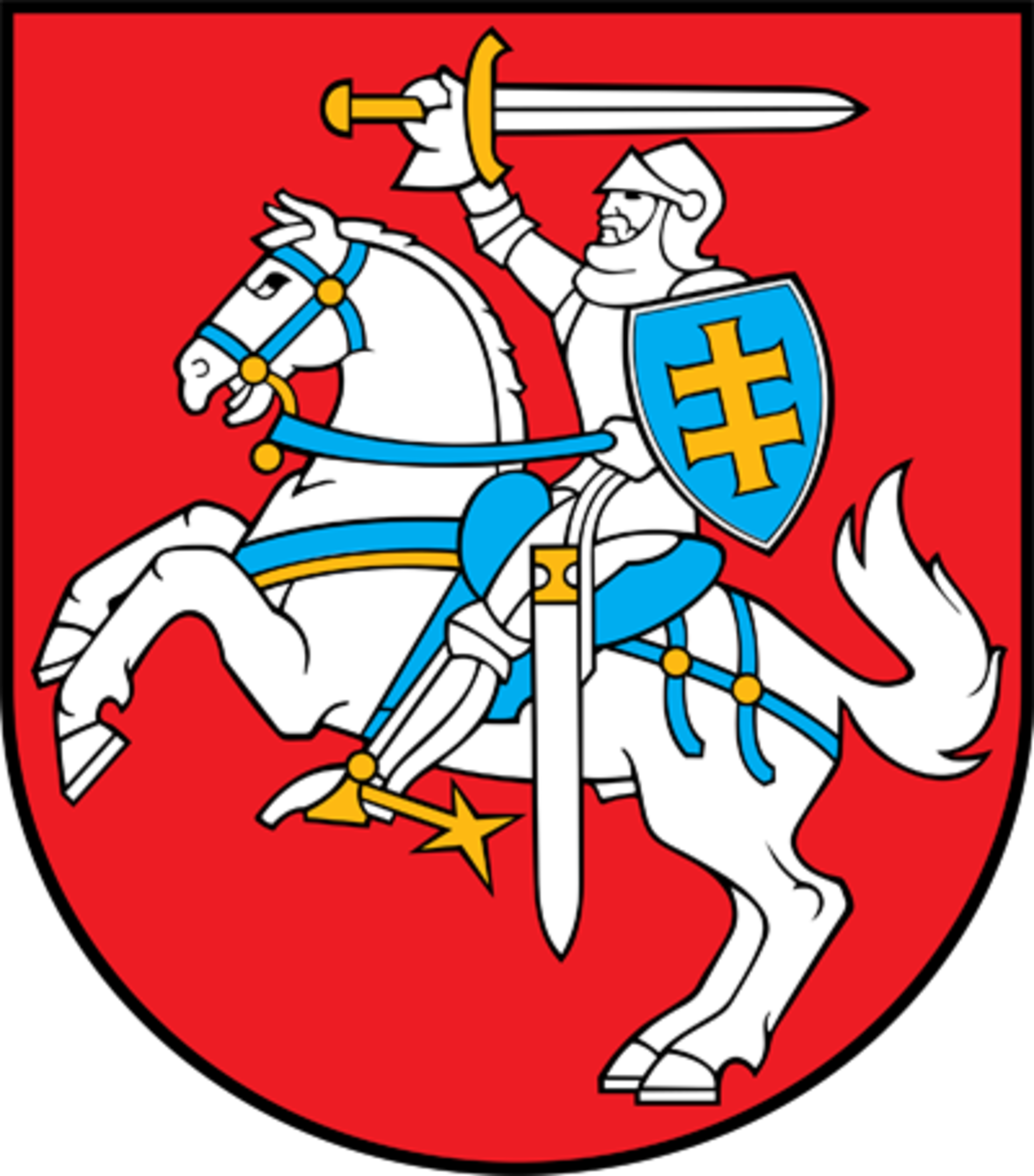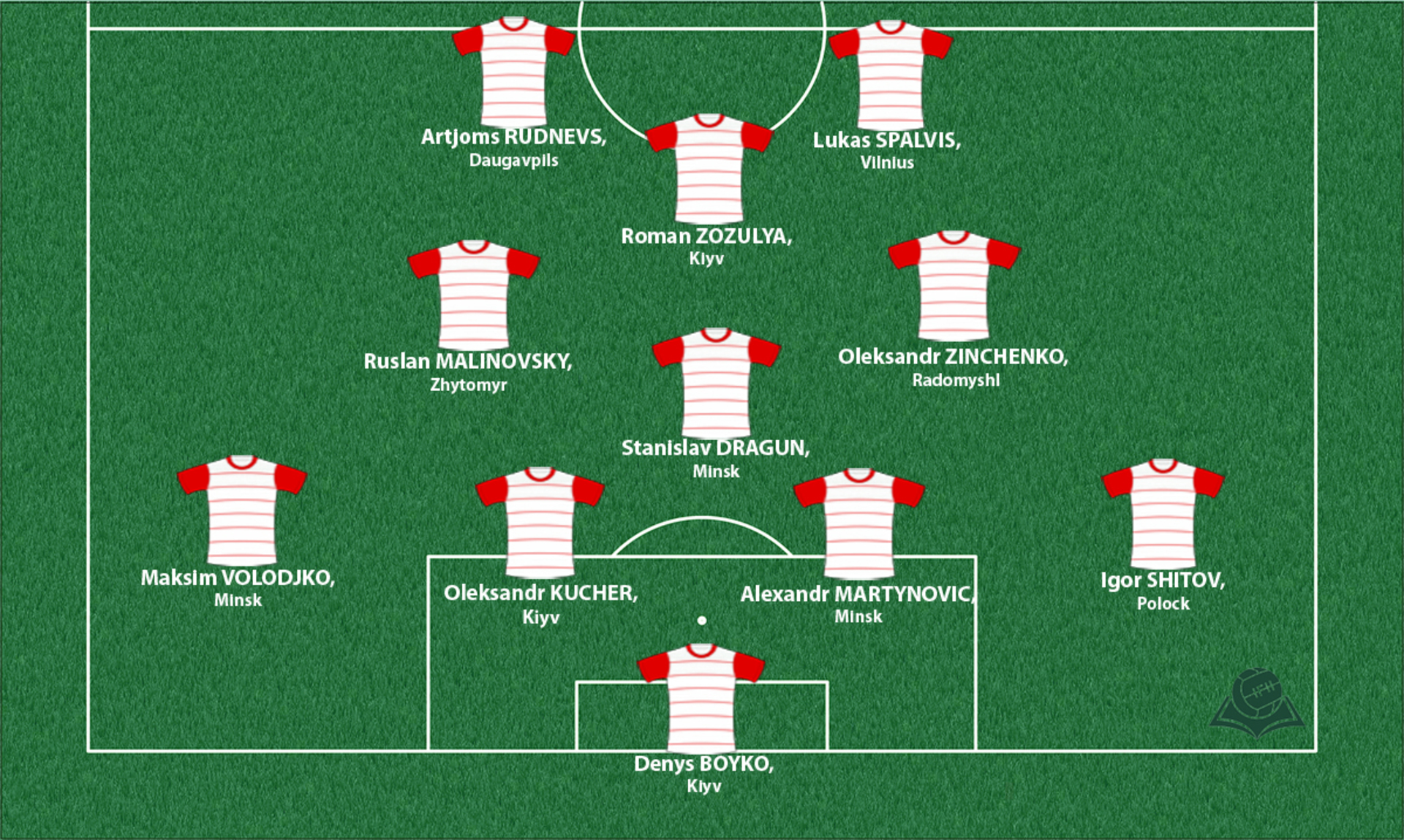The Duchy of Lithuania
Grand duchy of Lithuania became one of the most influential powers in eastern Europe in the14th century when it extended frontiers across the upper Dvina River in the northeast to the Dnjepar Rver in the southeast and to the Pripet Marshes in the south.

Coat of arms

Shirt
| Position | First name | Last name | Mjesto rođenja | Like | Dislike | |
|---|---|---|---|---|---|---|
| GK | Denys | BOYKO | Kiev |
6 |
1 |
|
| GK | Giedrius | ARLAUSKIS | Telšiai |
5 |
0 |
|
| GK | Oleksandr | RYBKA | Kiev |
2 |
1 |
|
| DC | Alexandr | MARTYNOVIC | Minsk |
6 |
2 |
|
| DC | Andriy | PYLYAVSKYI | Kiev |
1 |
0 |
|
| DC | Igor | PLASTUN | Kiev |
3 |
1 |
|
| DC | Oleksandr | KUCHER | Kiev |
7 |
1 |
|
| DC | Sergey | POLITEVICH | Lida |
0 |
0 |
|
| DLC | Maksim | BORDACHEV | Grodno |
0 |
0 |
|
| DRLC | Dennis | POLYAKOV | Minsk |
0 |
0 |
|
| DR | Igor | SHITOV | Polock |
0 |
0 |
|
| DL/AML | Maxim | VOLODJKO | Minsk |
2 |
1 |
|
| DMC | Nikita | KORZUN | Minsk |
0 |
0 |
|
| DMC | Syarhey | KISLYAK | Kamyanyets |
0 |
0 |
|
| MC | Ruslan | MALINOVSKY | Zhytomyr |
4 |
1 |
|
| MC | Stanislav | DRAGUN | Minsk |
1 |
0 |
|
| MC | Valeri | FEDORCHUK | Netishyn |
0 |
0 |
|
| AMC | Aleksandr | HLEB | Minsk |
1 |
0 |
|
| AMC | Anton | PUTSILA | Orsha |
0 |
0 |
|
| AMC | Vitaly | BUYALSKI | Kalynivka |
0 |
0 |
|
| AMRLC | Arvydas | NOVIKOVAS | Vilnius |
2 |
2 |
|
| AMRLC | Dmytro | LOPA | Kremenchuk |
1 |
0 |
|
| MRL | Ihar | STASEVICH | Borisov |
0 |
0 |
|
| AMRL/FC | Pavel | NEKHAJCHIK | Minsk |
0 |
0 |
|
| FRLC | Andriy | BORYACHUK | Vinnytsa |
5 |
1 |
|
| FRLC | Mikhail | GORDEJCHUK | Saran |
0 |
0 |
|
| FRLC | Roman | ZOZULYA | Kiev |
7 |
1 |
|
| FC | Artjoms | RUDNEVS | Daugavpils |
2 |
0 |
|
| FC | Davidas | SERNAS | Alytus |
3 |
0 |
|
| FC | Lukas | SPALVIS | Vilnius |
4 |
1 |
|
| FC | Pylyp | BUDKIVSKY | Kiev |
0 |
1 |
|
| AMRL/DL | Oleksandr | ZINCHENKO | Radomyshl |
19 |
1 |
(Today part of: Lithuania, Belarus, part of Latvia, central and western Ukraine, part of Russia)
The Lithuanian state emerged when Mindaugas proclaimed himself the king (1253), withthe pope’s blessing upon converting to Catholicism. The immediate cause of this move were probably the conflicts among Lithuanian nobility and the rising threat of the Catholic Teutonic Order, as well as the Tatar campaign approaching from the east. Nevertheless, the resistance of the pagan majority was not quelled by the first half of the 14th century, and by expanding the borders to the east and south many Orthodox Slavic peoples found themselves living in this country. In the future, their culture, language and script will become dominant even at the courts of the Grand Princes.
In the second half of the 14th century Lithuanian Grand Prince Jagiello, a converted Catholic, wed the Polish princess, bringing their two countries into a personal union. The union was justified, aside from the threat posed by external enemies (the Teutonic Order, the Principality of Moscow, the Tatars), with the economic and social reasons: merchants wanted to expand the market, Polish nobility wanted to expand the colonizing activities, Lithuanian princes andbojars were interested in transferring the Polish model of internal organization onto the state to Lithuania. However, there were numerous differences between the two cultures, languages, religions, organizations, legal systems, social structures, which simply denied the joining of a state organism such as Lithuania with the Polish Crown. In addition, the Lithuanian throne was hereditary, and Polish electoral, so as to preserve the Union until the dynasty had died out (1572),Jagiello kings will be elected to rule Poland. In general, various branches of the Jagiello family, from the 14th century to the beginning of the 16th century, came to rule numerous countries of Eastern and Central Europe through marriage pacts (the Crown of Saint Stephen, the Crown of Saint Wenceslas), whose interests differed, and who were often opposed to one another, so the strength of the dynasty was not comparable to the apparent power that the extent of their rule implied.
Sources
- Neven BUDAK, Tomislav RAUKAR, Hrvatska povijest srednjeg vijeka, Zagreb, 2006.
- Felipe FERNANDEZ-ARMESTO, Narodi Europe, Zagreb, 1997.
- Michal TYMOWSKI, Kratka povijest Poljske,Zagreb, 1999.
- ''Grand duchy of Lithuania'', https://www.britannica.com/place/grand-duchy-of-Lithuania
